Deyao Zhu
LightBagel: A Light-weighted, Double Fusion Framework for Unified Multimodal Understanding and Generation
Oct 27, 2025Abstract:Unified multimodal models have recently shown remarkable gains in both capability and versatility, yet most leading systems are still trained from scratch and require substantial computational resources. In this paper, we show that competitive performance can be obtained far more efficiently by strategically fusing publicly available models specialized for either generation or understanding. Our key design is to retain the original blocks while additionally interleaving multimodal self-attention blocks throughout the networks. This double fusion mechanism (1) effectively enables rich multi-modal fusion while largely preserving the original strengths of the base models, and (2) catalyzes synergistic fusion of high-level semantic representations from the understanding encoder with low-level spatial signals from the generation encoder. By training with only ~ 35B tokens, this approach achieves strong results across multiple benchmarks: 0.91 on GenEval for compositional text-to-image generation, 82.16 on DPG-Bench for complex text-to-image generation, 6.06 on GEditBench, and 3.77 on ImgEdit-Bench for image editing. By fully releasing the entire suite of code, model weights, and datasets, we hope to support future research on unified multimodal modeling.
Emerging Properties in Unified Multimodal Pretraining
May 20, 2025



Abstract:Unifying multimodal understanding and generation has shown impressive capabilities in cutting-edge proprietary systems. In this work, we introduce BAGEL, an open0source foundational model that natively supports multimodal understanding and generation. BAGEL is a unified, decoder0only model pretrained on trillions of tokens curated from large0scale interleaved text, image, video, and web data. When scaled with such diverse multimodal interleaved data, BAGEL exhibits emerging capabilities in complex multimodal reasoning. As a result, it significantly outperforms open-source unified models in both multimodal generation and understanding across standard benchmarks, while exhibiting advanced multimodal reasoning abilities such as free-form image manipulation, future frame prediction, 3D manipulation, and world navigation. In the hope of facilitating further opportunities for multimodal research, we share the key findings, pretraining details, data creation protocal, and release our code and checkpoints to the community. The project page is at https://bagel-ai.org/
Seed1.5-VL Technical Report
May 11, 2025Abstract:We present Seed1.5-VL, a vision-language foundation model designed to advance general-purpose multimodal understanding and reasoning. Seed1.5-VL is composed with a 532M-parameter vision encoder and a Mixture-of-Experts (MoE) LLM of 20B active parameters. Despite its relatively compact architecture, it delivers strong performance across a wide spectrum of public VLM benchmarks and internal evaluation suites, achieving the state-of-the-art performance on 38 out of 60 public benchmarks. Moreover, in agent-centric tasks such as GUI control and gameplay, Seed1.5-VL outperforms leading multimodal systems, including OpenAI CUA and Claude 3.7. Beyond visual and video understanding, it also demonstrates strong reasoning abilities, making it particularly effective for multimodal reasoning challenges such as visual puzzles. We believe these capabilities will empower broader applications across diverse tasks. In this report, we mainly provide a comprehensive review of our experiences in building Seed1.5-VL across model design, data construction, and training at various stages, hoping that this report can inspire further research. Seed1.5-VL is now accessible at https://www.volcengine.com/ (Volcano Engine Model ID: doubao-1-5-thinking-vision-pro-250428)
Causal Diffusion Transformers for Generative Modeling
Dec 17, 2024Abstract:We introduce Causal Diffusion as the autoregressive (AR) counterpart of Diffusion models. It is a next-token(s) forecasting framework that is friendly to both discrete and continuous modalities and compatible with existing next-token prediction models like LLaMA and GPT. While recent works attempt to combine diffusion with AR models, we show that introducing sequential factorization to a diffusion model can substantially improve its performance and enables a smooth transition between AR and diffusion generation modes. Hence, we propose CausalFusion - a decoder-only transformer that dual-factorizes data across sequential tokens and diffusion noise levels, leading to state-of-the-art results on the ImageNet generation benchmark while also enjoying the AR advantage of generating an arbitrary number of tokens for in-context reasoning. We further demonstrate CausalFusion's multimodal capabilities through a joint image generation and captioning model, and showcase CausalFusion's ability for zero-shot in-context image manipulations. We hope that this work could provide the community with a fresh perspective on training multimodal models over discrete and continuous data.
How Well Can Vision Language Models See Image Details?
Aug 07, 2024



Abstract:Large Language Model-based Vision-Language Models (LLM-based VLMs) have demonstrated impressive results in various vision-language understanding tasks. However, how well these VLMs can see image detail beyond the semantic level remains unclear. In our study, we introduce a pixel value prediction task (PVP) to explore "How Well Can Vision Language Models See Image Details?" and to assist VLMs in perceiving more details. Typically, these models comprise a frozen CLIP visual encoder, a large language model, and a connecting module. After fine-tuning VLMs on the PVP task, we find: 1) existing VLMs struggle to predict precise pixel values by only fine-tuning the connection module and LLM; and 2) prediction precision is significantly improved when the vision encoder is also adapted. Additionally, our research reveals that incorporating pixel value prediction as one of the VLM pre-training tasks and vision encoder adaptation markedly boosts VLM performance on downstream image-language understanding tasks requiring detailed image perception, such as referring image segmentation (with an average +10.19 cIoU improvement) and video game decision making (with average score improvements of +80.34 and +70.54 on two games, respectively).
Goldfish: Vision-Language Understanding of Arbitrarily Long Videos
Jul 17, 2024Abstract:Most current LLM-based models for video understanding can process videos within minutes. However, they struggle with lengthy videos due to challenges such as "noise and redundancy", as well as "memory and computation" constraints. In this paper, we present Goldfish, a methodology tailored for comprehending videos of arbitrary lengths. We also introduce the TVQA-long benchmark, specifically designed to evaluate models' capabilities in understanding long videos with questions in both vision and text content. Goldfish approaches these challenges with an efficient retrieval mechanism that initially gathers the top-k video clips relevant to the instruction before proceeding to provide the desired response. This design of the retrieval mechanism enables the Goldfish to efficiently process arbitrarily long video sequences, facilitating its application in contexts such as movies or television series. To facilitate the retrieval process, we developed MiniGPT4-Video that generates detailed descriptions for the video clips. In addressing the scarcity of benchmarks for long video evaluation, we adapted the TVQA short video benchmark for extended content analysis by aggregating questions from entire episodes, thereby shifting the evaluation from partial to full episode comprehension. We attained a 41.78% accuracy rate on the TVQA-long benchmark, surpassing previous methods by 14.94%. Our MiniGPT4-Video also shows exceptional performance in short video comprehension, exceeding existing state-of-the-art methods by 3.23%, 2.03%, 16.5% and 23.59% on the MSVD, MSRVTT, TGIF, and TVQA short video benchmarks, respectively. These results indicate that our models have significant improvements in both long and short-video understanding. Our models and code have been made publicly available at https://vision-cair.github.io/Goldfish_website/
MiniGPT-Med: Large Language Model as a General Interface for Radiology Diagnosis
Jul 04, 2024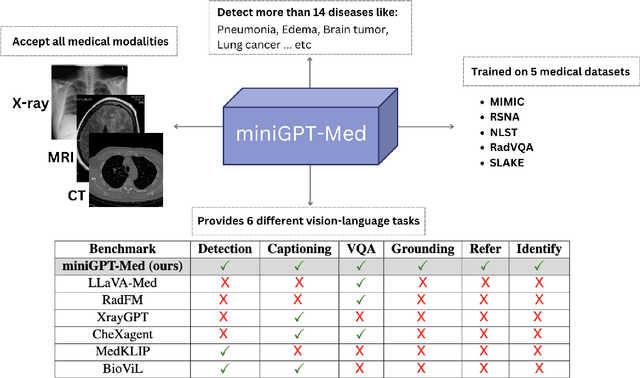

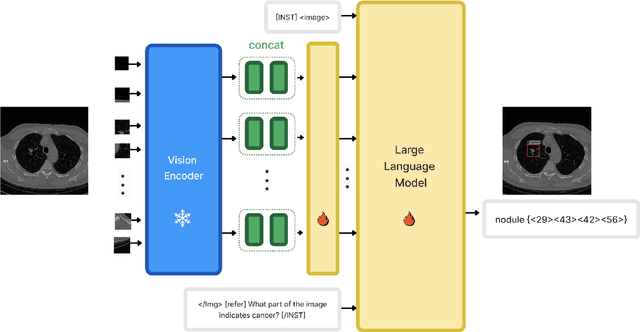
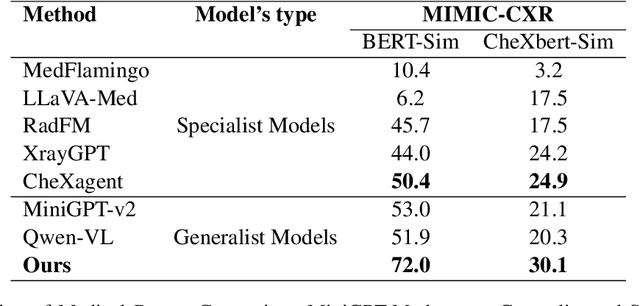
Abstract:Recent advancements in artificial intelligence (AI) have precipitated significant breakthroughs in healthcare, particularly in refining diagnostic procedures. However, previous studies have often been constrained to limited functionalities. This study introduces MiniGPT-Med, a vision-language model derived from large-scale language models and tailored for medical applications. MiniGPT-Med demonstrates remarkable versatility across various imaging modalities, including X-rays, CT scans, and MRIs, enhancing its utility. The model is capable of performing tasks such as medical report generation, visual question answering (VQA), and disease identification within medical imagery. Its integrated processing of both image and textual clinical data markedly improves diagnostic accuracy. Our empirical assessments confirm MiniGPT-Med's superior performance in disease grounding, medical report generation, and VQA benchmarks, representing a significant step towards reducing the gap in assisting radiology practice. Furthermore, it achieves state-of-the-art performance on medical report generation, higher than the previous best model by 19\% accuracy. MiniGPT-Med promises to become a general interface for radiology diagnoses, enhancing diagnostic efficiency across a wide range of medical imaging applications.
MiniGPT4-Video: Advancing Multimodal LLMs for Video Understanding with Interleaved Visual-Textual Tokens
Apr 04, 2024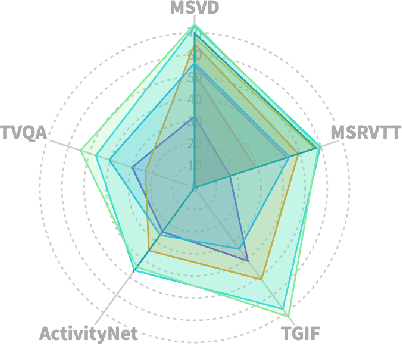

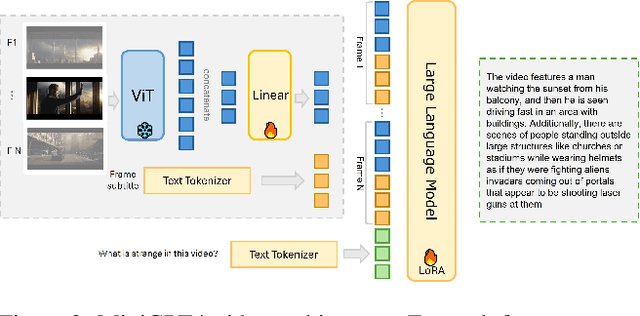

Abstract:This paper introduces MiniGPT4-Video, a multimodal Large Language Model (LLM) designed specifically for video understanding. The model is capable of processing both temporal visual and textual data, making it adept at understanding the complexities of videos. Building upon the success of MiniGPT-v2, which excelled in translating visual features into the LLM space for single images and achieved impressive results on various image-text benchmarks, this paper extends the model's capabilities to process a sequence of frames, enabling it to comprehend videos. MiniGPT4-video does not only consider visual content but also incorporates textual conversations, allowing the model to effectively answer queries involving both visual and text components. The proposed model outperforms existing state-of-the-art methods, registering gains of 4.22%, 1.13%, 20.82%, and 13.1% on the MSVD, MSRVTT, TGIF, and TVQA benchmarks respectively. Our models and code have been made publicly available here https://vision-cair.github.io/MiniGPT4-video/
MiniGPT-v2: large language model as a unified interface for vision-language multi-task learning
Oct 26, 2023



Abstract:Large language models have shown their remarkable capabilities as a general interface for various language-related applications. Motivated by this, we target to build a unified interface for completing many vision-language tasks including image description, visual question answering, and visual grounding, among others. The challenge is to use a single model for performing diverse vision-language tasks effectively with simple multi-modal instructions. Towards this objective, we introduce MiniGPT-v2, a model that can be treated as a unified interface for better handling various vision-language tasks. We propose using unique identifiers for different tasks when training the model. These identifiers enable our model to better distinguish each task instruction effortlessly and also improve the model learning efficiency for each task. After the three-stage training, the experimental results show that MiniGPT-v2 achieves strong performance on many visual question-answering and visual grounding benchmarks compared to other vision-language generalist models. Our model and codes are available at https://minigpt-v2.github.io/
Exploring Open-Vocabulary Semantic Segmentation without Human Labels
Jun 01, 2023Abstract:Semantic segmentation is a crucial task in computer vision that involves segmenting images into semantically meaningful regions at the pixel level. However, existing approaches often rely on expensive human annotations as supervision for model training, limiting their scalability to large, unlabeled datasets. To address this challenge, we present ZeroSeg, a novel method that leverages the existing pretrained vision-language (VL) model (e.g. CLIP) to train open-vocabulary zero-shot semantic segmentation models. Although acquired extensive knowledge of visual concepts, it is non-trivial to exploit knowledge from these VL models to the task of semantic segmentation, as they are usually trained at an image level. ZeroSeg overcomes this by distilling the visual concepts learned by VL models into a set of segment tokens, each summarizing a localized region of the target image. We evaluate ZeroSeg on multiple popular segmentation benchmarks, including PASCAL VOC 2012, PASCAL Context, and COCO, in a zero-shot manner (i.e., no training or adaption on target segmentation datasets). Our approach achieves state-of-the-art performance when compared to other zero-shot segmentation methods under the same training data, while also performing competitively compared to strongly supervised methods. Finally, we also demonstrated the effectiveness of ZeroSeg on open-vocabulary segmentation, through both human studies and qualitative visualizations.
 Add to Chrome
Add to Chrome Add to Firefox
Add to Firefox Add to Edge
Add to Edge